
Rich Messaging is taking the communication world by storm; it’s no longer limited to plain text and is therefore not static anymore. It has transformed communication into a dynamic and interactive experience. Imagine you receive a message from a business that feels like a mini website rather than a simple text. It has a nice image of the product, a clickable “Buy Now” button, and a live chat option to resolve instant queries.
Sounds amazing, right?
Today, rich messaging is helping businesses build deeper connections with customers by enhancing their buying journeys with interactive and immersive experiences. Through this blog, let’s explore what is rich messaging and how it is transforming communication from passive text to dynamic conversations.
History of Text Messaging and Rich Messaging
SMS had its humble beginnings in the 1990s when it was limited to plain text and strict character limits (typically 160 characters) per message. On December 3, 1992, Neil Papworth, a 22-year-old test engineer for Sema Group in the UK, sent the first text message, “Merry Christmas,” from a personal computer to a phone via the Vodafone network. As mobile technology advanced and smartphones emerged, the demand for richer and more expressive messaging took traction.
It was in the late 2000s when Multimedia Messaging Services or MMS came into existence and marked a significant shift. With MMS, users gained the ability to send and receive pictures, videos, audio clips, and animated GIFs. This shift toward more visual, colorful, interactive, and personalized communication paved the way for richer, more expressive, and engaging messaging – what today we know as ‘Rich Messaging’.
Let’s glance at some key milestones that marked the journey of Rich Messaging:
2007
A group of industry promoters formed “The Rich Communication” Suite to fortify traditional SMS and MMS messaging with advanced features of popular internet-based messaging apps.
2008
In February, The GSMA or GSM Association officially adopted RCS. An official committee was established in September and some basic specifications in terms of definition, testing, and integration were released.
2011
After 3 years in May 2011, GSMA released a new specification called RCS-e (e = enhanced) with iterations to the original specifications.
2012
Spain’s major telecom operators launched RCS-e services under the Joyn brand.
2016
The GSMA published the Universal Profile of RCS in November. This created a standardized, interoperable version of RCS that would work across different mobile networks and devices.
2017
By early 2017, there were 47 mobile network operators, 11 manufacturers, and 2 OS providers (Google and Microsoft) that had announced their support of the Universal Profile. Google’s Jibe Cloud platform is an implementation of the RCS Universal Profile, designed to help carriers launch RCS quickly and scale easily.
2019
Google announced releasing of RCS to its Android users, aiding overall adoption. Also, in October 2019, the four major U.S. carriers announced an agreement to form the Cross-Carrier Messaging Initiative to jointly implement RCS using a newly developed app.
What is Rich Messaging?
RCS is an evolution of standard text messages i.e. SMS. It packs SMS communication with several interactive elements to generate engaging and enriching interactions. These elements are usually in the form of images, videos, buttons, voice messages, carousals, GiFs, location sharing, interactive menus, etc. Using rich messaging, users can convey emotions, show creativity, and share experiences more expressively. Rich messaging capabilities are typically found in various messaging platforms, social media apps, and communication tools.
What is RCS Chat?
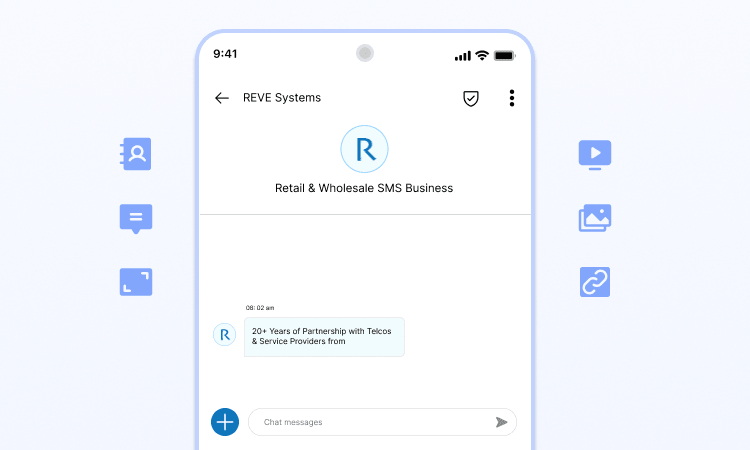
RCS Chat or Rich Communication Services Chat is a type of rich messaging that uses RCS protocol for communication. This advanced messaging protocol enhances traditional SMS with rich multimedia features. You can think of RCS as an ‘upgrade’ to SMS.
It offers features similar to OTT i.e. Over-the-Top messaging apps such as WhatsApp, but it is directly integrated into the native messaging apps on smartphones. Some of the key features offered by RCS chat are multimedia sharing like high-resolution images and videos, in-call multimedia sharing, group chat enabling group conversations with read receipts and typing indicators, large file transfer, etc. RCS also enables end-to-end encryption to protect communication from interception.
Will Rich Messaging Replace SMS?
Today, users demand engagement when it comes to communication and SMS is simply not enough to meet such demands. Although Rich Messaging presents significant advantages such as broader reach, cost-effectiveness, and feature-rich communication, its dominance is highly probable. Nevertheless, it’s unrealistic to anticipate it entirely replace the legacy SMS. Here are valid reasons for its continued coexistence.
- Replacing the legacy infrastructure of SMS is expensive and time-consuming for carriers.
- Interoperability is another hurdle when rich messaging happens across diverse networks and regions.
- Some users prefer the simplicity and familiarity of SMS for their communication needs, especially in areas with older demographics and limited data access.
Though RCS is becoming increasingly popular for personal communication and business outreach, we cannot ignore the popularity of SMS. Rather these two communications technologies are likely to coexist in the foreseeable future.
RCS vs. SMS and MMS vs. OTT Messaging Apps
While we have understood the difference between SMS and Rich Messaging, we can say that rich messaging takes conventional text messaging to an advanced level. We shall now look at the similarities and differences between RCS and other messaging technologies including MMS and OTT to truly understand the capabilities and benefits of RCS technology.
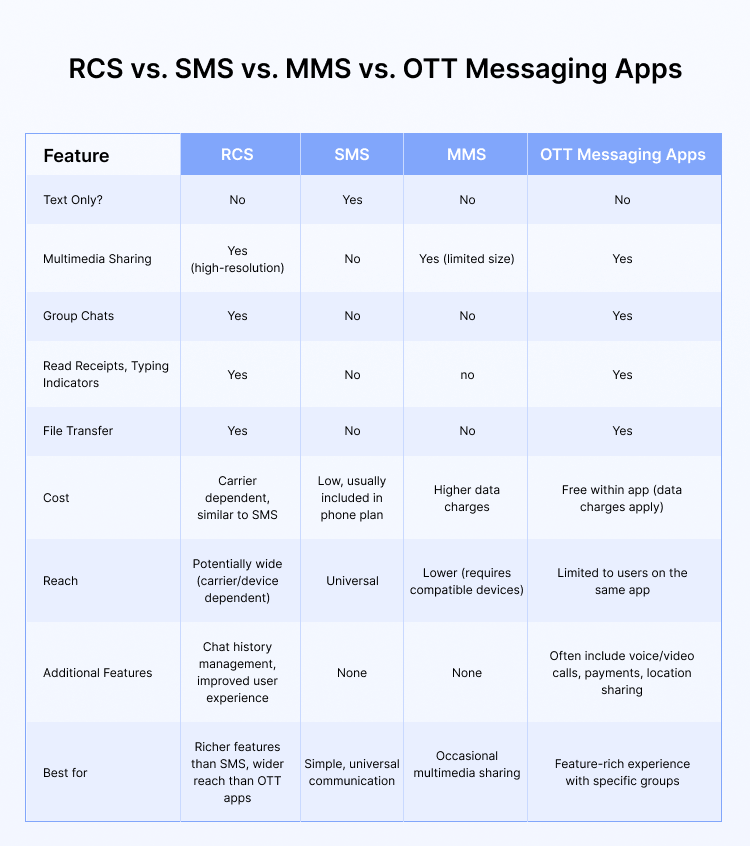
How Businesses are Using Rich Business Messaging?
Let me help you understand with an example. When you open a website, usually an online chat box pops up with a notification like “How may I help you?”. These live chat boxes are one way how businesses are using rich business messaging. From product images to video tutorials and setting automatic replies in the live chat are some ways through which businesses can elevate customer experience. When customers have such prompt assistance by their side, the likelihood of them buying services becomes quite high.
Major industry players including Google and Apple make continuous efforts to enhance the communication experience of their customers. Let’s discuss how they leverage rich messaging.
Google’s Approach to Rich Messaging
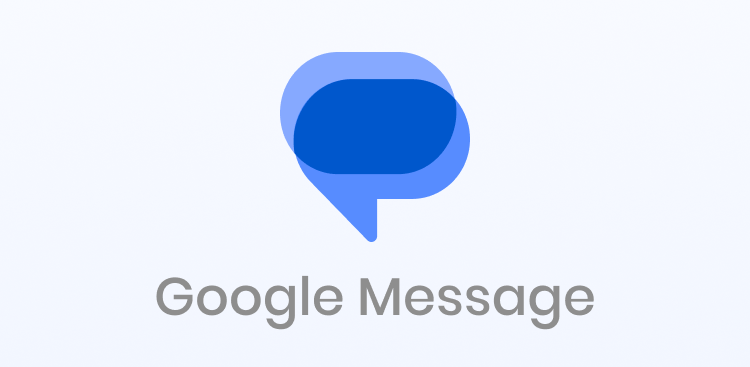
Google’s messaging platform, Google Messages serves as the default messaging app on various Android smartphones and supports basic SMS and MMS functionalities. In terms of rich messaging, Google Messages incorporates the RCS protocol and its capabilities to provide users with a myriad of features. These include high-resolution image and video sharing, read receipts, typing indicators, as well as group chats, group naming, adding and removing participants, reacting to messages using emojis and stickers, etc. Users can also enjoy interactive content within their messages using interactive buttons, rich cards, and suggested replies.
Apple’s Approach to Rich Messaging
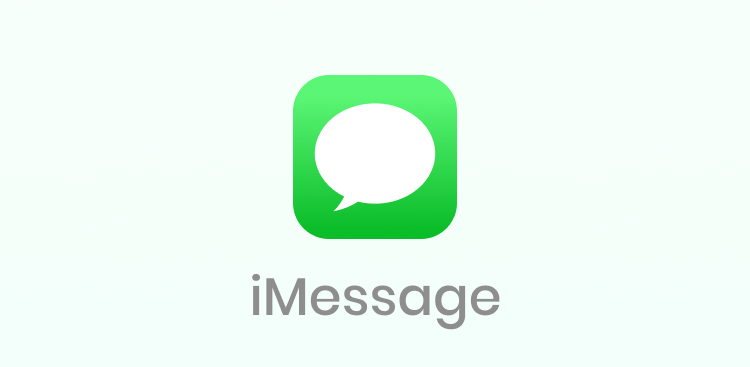
Currently, Apple does not support RCS within any of its native apps. Rather it focuses on its proprietary messaging platform, iMessage, which incorporates rich messaging features. Through this strategic decision, Apple maintains control over the messaging experience and potentially encourages users to stay within the Apple product family for seamless communication.
iMessage primarily caters to users within the Apple ecosystem and offers a rich and immersive messaging experience. This includes features like multimedia messaging, stickers, emojis, and digital touch effects. While iMessage focuses on end users, Apple offers a rich messaging experience for the business segment through its initiatives like Apple Business Chat (by the way, it is actually messaging).
However, in November 2023, Apple recognized the growing adoption of RCS and announced their plan to add support for the RCS Universal Profile somewhere around November 2024. Source . So shortly, we can expect Apple to adopt or come up with its own version of RCS.
Features of Rich Text Messaging
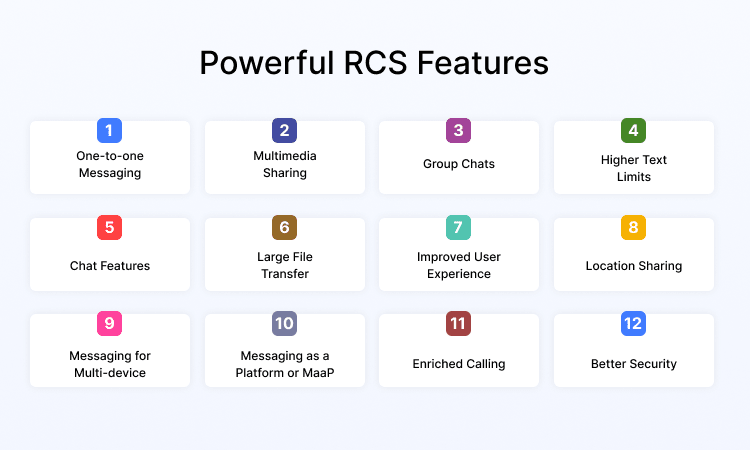
There’s not just one but a myriad of features that make Rich Messaging do a lot better than SMS and MMS. Let’s take a look:
-
One-to-one Messaging
Users can send messages and other chat elements with one another through one-to-one messaging.
-
Multimedia Sharing
Using RCS, users can send and receive high-resolution files including images, videos, GIFs, documents, etc. This can be shared within one-to-one and group conversations.
-
Group Chats
RCS enables users to enjoy secure group conversations with their friends, family, and teams using features like reading receipts and typing indicators. Such a chat can be initiated by creating a group and inviting multiple participants to it.
-
Higher Text Limits
RCS enables users to send 250,000 characters at once which makes it a much better alternative to traditional SMS limited to 160 characters.
-
Chat features
Users can utilize features like read receipts, typing indicators, and chatbots for improved communication flow and to make conversations more interesting both in personal and business communication.
-
Large File Transfer
Rich Communication Services allows users to send and receive larger files of up to 10MB in size effortlessly.
-
Location Sharing
Users can share their current location with others both in one-to-one and group conversations.
-
Messaging for Multi-device
Rich Text Messaging users can register on and use multiple devices such as smartphones, tablets, etc., under a single identity.
-
Messaging as a Platform or MaaP
Users can enable MaaP, thus leveraging the capabilities of RCS to communicate with customers via automated programs, or chatbots that can interact in a natural language format.
-
Enriched Calling
Moving beyond the traditional calling experience, users can share visual elements like images, videos, location information, etc., during voice calls. This simply makes communication more dynamic, and engaging.
-
Better Security
RCS offers fully verified sender IDs which makes it easier for businesses to build trust and drive engagement amongst the customers.
Benefits of RCS Business Messaging
At their IO conference in May 2022, Google announced that there are 650 million monthly users and that they expect to hit a billion before the end of 2023. Google’s data also suggests that people are 35x more likely to read RCS than email, and 74% more likely to engage with brands using RCS.
The above statistics showcase the growing popularity of RCS, however, it is important to understand how it can benefit your specific business. Let’s discuss:
-
A Powerful Sales and Marketing Tool
With RCS, businesses can reach particular segments of customers through targeted campaigns. By creating personalized messages based on the customers’ demographics, preferences, interests, and purchasing behavior, the likelihood of conversion becomes quite high. Inculcating interactive elements like clickable buttons, forms and CTAs such as payment options within the messages encourages customers to take action instantly.
Furthermore, RCS business messaging provides businesses with valuable insights about campaign performance, customer engagement, and message effectiveness. From message delivery rates, and open rates to CTRs and conversion rates, having such useful analytics allows businesses to optimize their strategies for better results.
-
Improves Brand Perception
RCS business messaging allows businesses to showcase their brand, products, and services more compellingly and memorably. They can display their brand identity with a verified brand name and logo along with customized message backgrounds, colors, and fonts. This leaves a positive impression on customers and reinforces brand loyalty.
-
Enhances Customer Experience
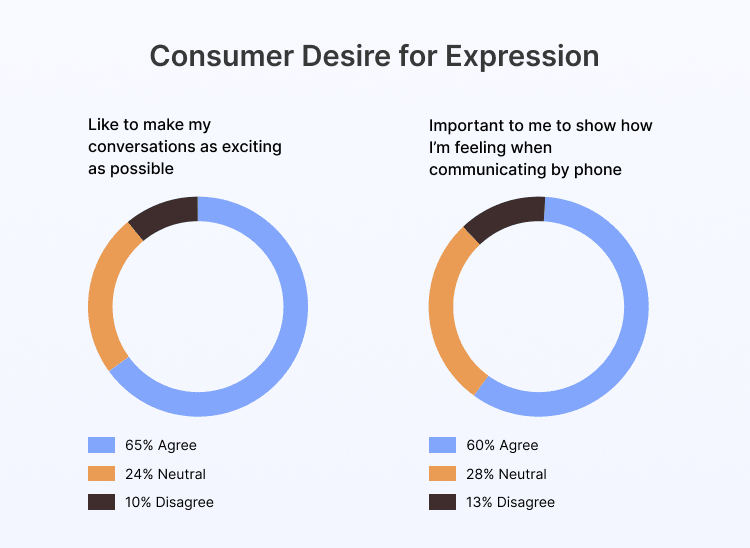
RCS simply goes beyond the plain text and allows businesses to share HD images, videos GIFs, and carousels to make their information more attractive. Tailored messages offering customers product recommendations and customized offers help in increasing engagement. Moreover, the RCS enables 2-way communication through chatbots and live agents, to resolve concerns and answer questions instantly.
-
Increased Revenue

RCS enables mobile operators to generate additional revenue streams. This can be done by offering special messaging services like premium SMS and sponsored messages, for which businesses are ready to pay an extra amount of money. It is just like buying premium features of an online game. By partnering with businesses, mobile operators can create a win-win situation for both parties as they earn extra money and users get cooler ways to text.
-
Enhanced Collaboration
With its interactive and dynamic features, RCS or rich messaging provides users with a versatile communication platform. Features like rich media sharing, group chats, and interactive features such as polls, reactions, and live annotations within chat simply boost communication and engagement. The quick and secure file transfer capabilities in real-time make way for enhanced productivity and workflow. Further, business teams can have multi-device access and even communicate when they are offline fostering increased accessibility and flexibility.
-
Future-Proof Communication

Several reasons support the ‘Future-Proofingness’ of RCS. The interoperability of RCS between various networks, devices, and messaging apps enables it to evolve and adapt to changes in the expectations of the users. Moreover, RCS is designed to integrate with advanced technologies such as AI, ML, and NLP, which means it can leverage emerging technologies to enhance its capabilities and address the needs of the users.
More importantly, RCS is based on open standards defined by the GSMA that work continually to update and enhance the specifications of this messaging technology. Through its Universal Profile (UP), GSMA ensures that RCS remains relevant and competitive in the mobile messaging realm.
-
Reliable Fallbacks
In situations when the recipient’s device or network does not support RCS, the reliable fallback protocol in RCS ensures that the messages are still delivered reliably and consistently. This is done through a fallback protocol, another app, SMS, or MMS. So no matter what, your RCS messages always get delivered, one way or the other.
Real-World Application of Rich Messaging
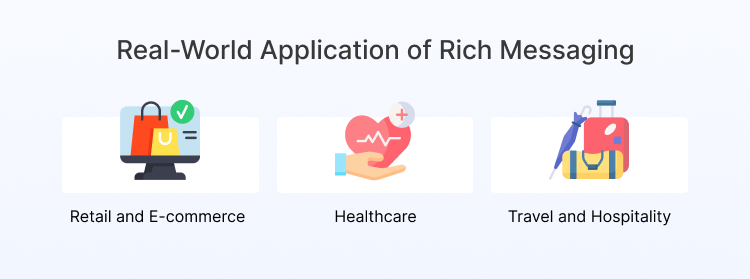
While we have already discussed the implementation of rich messaging by Apple and Google, we shall now see how businesses in diverse sectors can leverage rich messaging to deliver personalized, engaging, and interactive experiences to their customers.
Retail and E-commerce
Retail can greatly benefit from rich messaging by showcasing products with high-resolution images, videos, and even 360-degree views. Such attractive product demos and interactive catalogs can create more customer engagement. Also, based on the purchase history and browsing behavior, personalized offers and product recommendations can be sent to the customers. Lastly, offering seamless purchasing options like the ‘Buy Now’ buttons within the chat can boost conversion rates.
Healthcare
Another segment where rich messaging offers wide benefits is healthcare. Appointment reminders, medication alerts, and wellness tips combined with visual content can improve communication and engagement. Besides this, Remote Consultation can also be done effectively via RCS chat. Patients can have interactive conversations with healthcare professionals where they can discuss their symptoms, ask questions, share reports, and receive advice. All this can happen in real time.
Travel and Hospitality
Rich messaging takes communication in the travel and hospitality industry to a different level. Travel agencies and agents can share travel documents, boarding passes, and itinerary updates with dynamic visuals to keep communication with customers interactive. Furthermore, sharing crucial updates like flight delays and baggage claim information can be done instantly or in real-time. What’s more? Hotels and homestay businesses can conduct virtual tours and showcase stay amenities with immersive experiences.
How to Grow Your Business Using Rich Text Messaging
If you still think that RCS might not work for your business, we suggest you give it a thought again. Remember that messages are an essential form of communication in your customers’ day-to-day lives. Leveraging the power of these rich messages, you can tap several untouched avenues.
Dynamic Promotions
Suppose you launched a sale a few minutes back, then will you wait for your emails to reach your customers which they are probably going to ignore? Use RCS and send up-to-the-minute information about your sales and promotions to your customers. With personalized messages, you can direct them to your online store or even your physical address and they can choose whatever they prefer. All this right within the messages!
Account Alerts
Alerts have been often limited to SMS or specific mobile apps. However, with RCS, you can send alerts such as fraud alerts, payment confirmations/ reminders, service reminders, etc., directly to your customers’ inboxes. Besides providing the information to the customer, you can give them options for further actions as well.
Personalized Recommendations

Leveraging existing customer data and preferences, businesses can offer personalized recommendations using RCS messaging. For this various factors including purchasing history, demographics, engagement level, etc., can be considered. Based on the customer profile, the business can personalize messages with specific recommendations such as product suggestions, promotional offers, etc. Interactive elements such as buttons, carousels, quick replies, etc. can be added to generate more engagement.
For example, you are an online clothing store leveraging RCS to provide personalized recommendations to customers. The message could be like –
“Hi [Customer Name], have you checked our new arrivals? Take a look at our latest collection of winter jackets and accessories. Want to see more? Reply with ‘Show More’ or ‘Shop Now’ to explore further. Happy Shopping!”
In this example, a few key points to be ensured are:
- The customer shall be addressed with their real name
- The recommendations should be based on the specific interests of the customer
- Interactive elements like “Shop More” buttons should be there
- The timing of the message should align with the start of the winter season
- Usage of relevant emojis and icons with the message body
How to Make a Great RCS Strategy? 3 Proven Tips
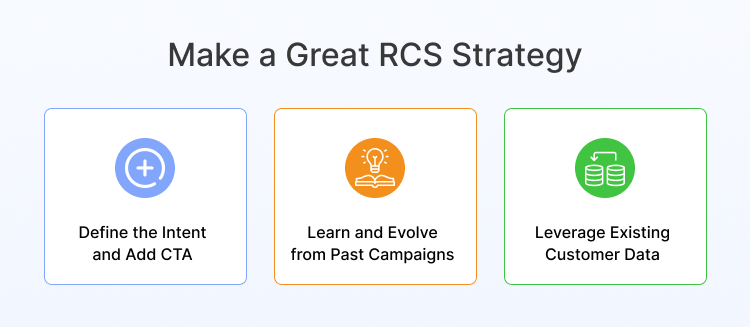
By now, I’m sure you are convinced of the potential of RCS and want to implement it into your communication strategy. Well, here are some tried and tested tips that can help you move in the right direction.
-
Define the Intent and Add CTA
Before you hit that send button, it is important to understand the purpose behind your RCS communication. Suppose you want to announce a sale through your RCS messages then you need to add a relevant CTA such as a “Get this Offer Now” button that takes the customer directly to the sale page.
-
Learn and Evolve from Past Campaigns
It is always a good idea to learn from your past efforts. Evaluate and analyze your older campaigns, even if those were email and SMS-based campaigns. Filter out the successful ones and look for what worked well. Then leverage RCS to enhance those campaigns with new, exciting, and interactive elements. In simple words, it’s about keeping what worked and making it even better with the RCS.
-
Leverage Existing Customer Data
How about using the information you already have about your customers? Well, this can be a useful shortcut to understand them better and serve them more effectively. You have data scattered across different sources like purchasing behaviors, interactions, feedback, etc. You can combine this data by putting together the pieces of a puzzle and building customer profiles. Once you have those, you can come up with smarter marketing tactics using RCS.
Bottom Line – Embracing Rich Messaging
In the GSMA Open Market RCS Research Study, it was found that “Nearly 80% of consumers find RCS appealing and 74% say RCS would make them more likely to want to communicate with a brand.
As the world of communication continues to evolve, the adoption of Rich Messaging powered with RCS is certainly a leap forward. From enhancing collaboration between users and facilitating personalized recommendations, Rich Messaging emerges as a powerful tool for businesses and individuals alike. Let’s embrace the future of messaging with Rich Text Messaging.




























